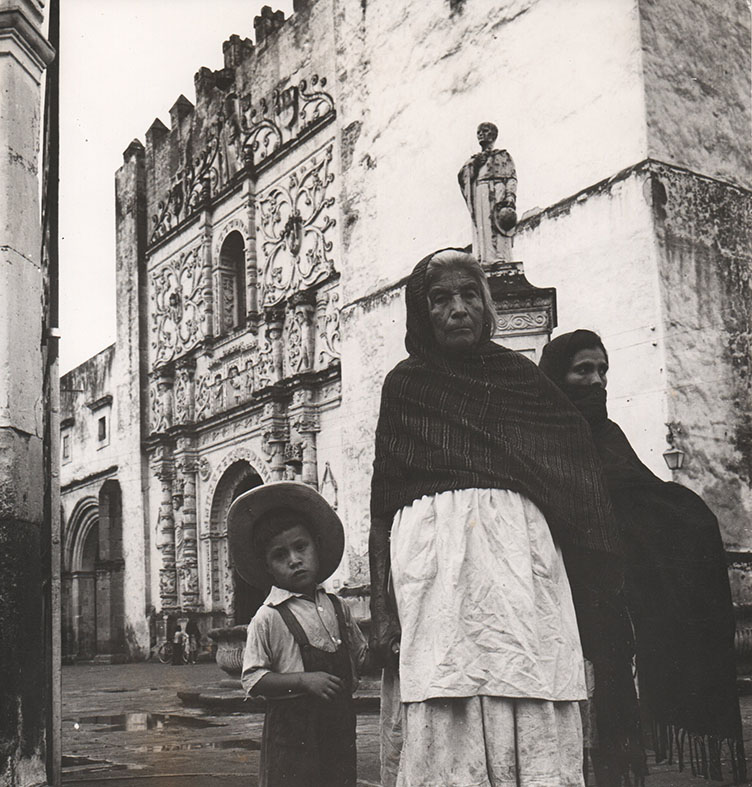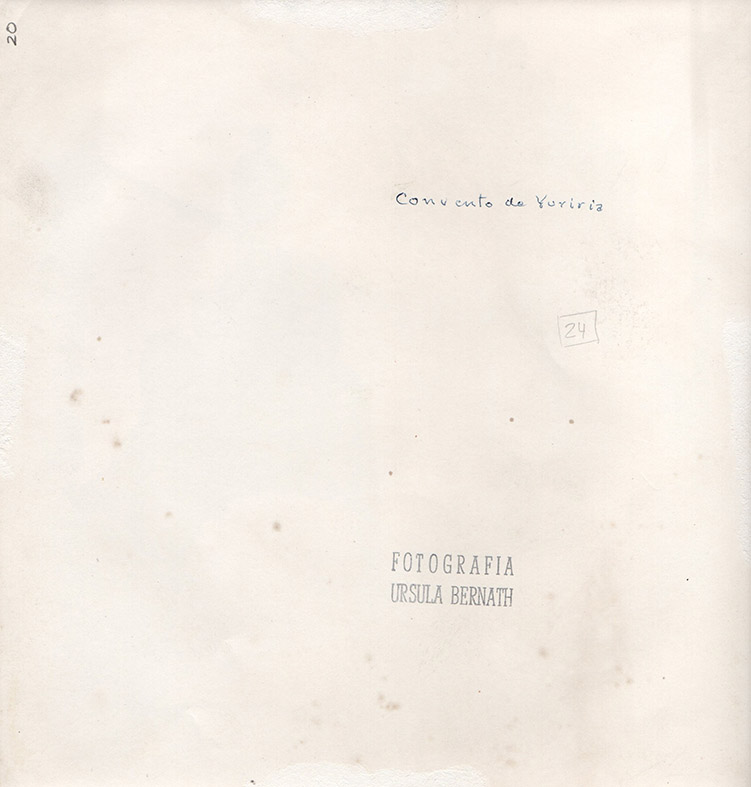Yuriria Convent. Guanajuato. Mexico. Third quarter of the 20th century.
Vintage gelatin silver copy; work without white margins Measurements: 22 x 19 cm / 8.66 x 7.48 in. On the back is located the wet stamp -in black ink- authored: “Úrsula Bernath Photography” and handwritten, presumably by the same photographer: “Yuriria Convent”.
In the primitive Mexico of the Spanish conquest of the 16th century, the Franciscan, Dominican and Augustinian religious divided up territorial regions for their evangelization, advancing on the extensive domains of the various indigenous communities. In the case of Yuriria, in the mining region of Guanajuato, the Augustinians formed the first town around the 1540s, although three years earlier they had already built a small chapel. The territory had serious problems due to the presence of large swamps that affected the indigenous people with malaria; This explains that one of the most relevant works was the construction of a canal that allowed the transfer of water to generate clean lagoons around 1550. Once the habitability of the place was assured, the construction of the convent and the adjoining temple began, tasks that demanded a decade of architectural work.
The process of evangelization among these native peoples who did not use large closed spaces, practicing their religious cults in open-air ceremonial centers (1), forced the Spaniards to modify the traditional religious architecture applying different solutions, such as chapels with covered altars but, open to the atrium: the so-called “open chapels”. Sometimes, as in Yuriria, they are on the same floor of the atrium next to the portal of the temple, under an arcade that also has access to the convent. In the Andean case, the balconies above the façade of the temple are frequently accessed by the priest from the internal choir.
These 16th century convent temples followed European Gothic traditions due to their great height and were generally narrow; The first temples were covered many times with wood and, later, to avoid the strong lateral thrust of the ribbed vaults, which frequently forced the use of robust buttresses on the outside, precisely to avoid the collapse of their high side walls.
In the specific case of the Yuriria complex, located in the proximity of an active border and composed of very bellicose ethnic groups, it shows the inhabitants on the front of the Church defending themselves with bows and arrows from their enemies, all wrapped in a series of elements vegetables that cover the walls. The façade ends in a battlement that extends throughout the roof and that indicates the semi-military character of the construction, which fulfilled the same role of refuge, with its military walkway on the roof as those of medieval castles Spanish people. The façade is, however, of a Renaissance structure and on one side the open front chapel opens for direct communication to the outside. The predominance of the mass of volume with a tower of great dimensions, although low, shows the idea of a fortified convent of the whole. The small dimensions of the cloister and the massive expression of the buttresses confirm this dominance of the volumes.
The significant photograph by Úrsula Bernath emphasizes the contrast between the great ornamental display of the temple's façade, with the simplicity and dark sobriety of the clothes of the two peasant women and the boy that make up a striking foreground and, above which, the monument to the Augustinian founder who holds in his hands a 16th century hat, very similar to that of the 20th century child. Obviously we are facing a double look that is feminine and European.
Born in Leipzig (Germany) in 1915, she emigrated to Mexico in the postwar period around 1946 and joined the Italian Tina Modotti and the circle of artists formed, among others, by Diego Rivera, Frida Kahlo and Gertrude Duby Blom, well-known artists who motivated her. to document the expressions of the authentic indigenous and rural world through anthropological photography, as did other of his gender colleagues such as the Polish Bernice Kolko and the Austrian Ruth Lechuga. However, Úrsula Bernath did it with a particular vision, without a manifest concern for aesthetic composition, seeking to highlight above all the documentary nature of her black and white images. She passed away in Mexico City in 2011.
Note:
1. The indigenous Mexicans like the Andeans did not use large closed spaces, due to technical problems to cover them. The Mayans and Aztecs built with stones with advanced courses that allowed them very small spaces, for that reason they only had small temples on the pyramids to which the priests had access.
| AUTHOR | ÚRSULA BERNATH |
|---|
Are you interested in selling some works?
Send us an email briefly indicating
which works you intend to put on sale, and we will respond. click here
Subscribe to our newsletter to be updated.
Check our Newsletters
